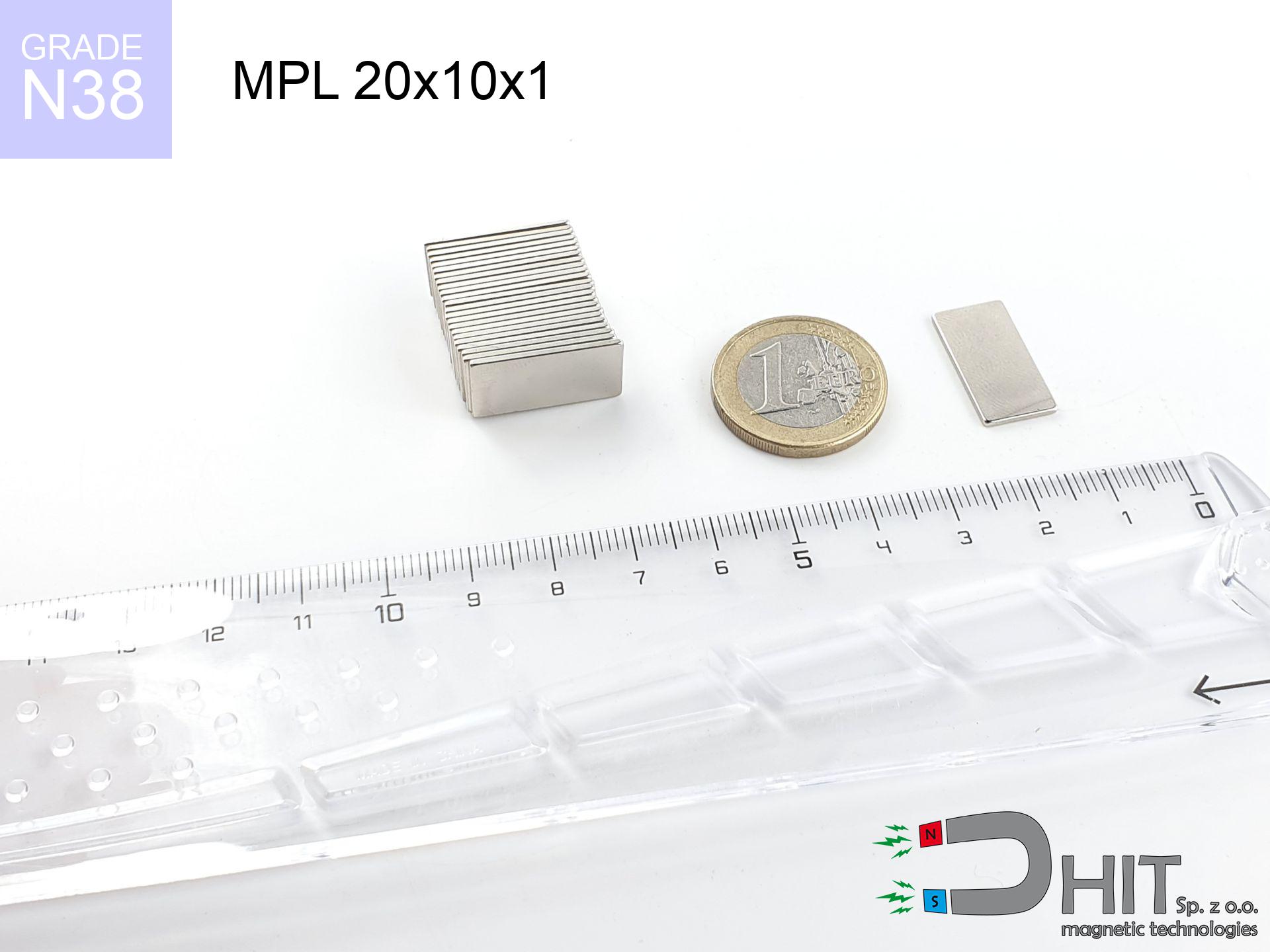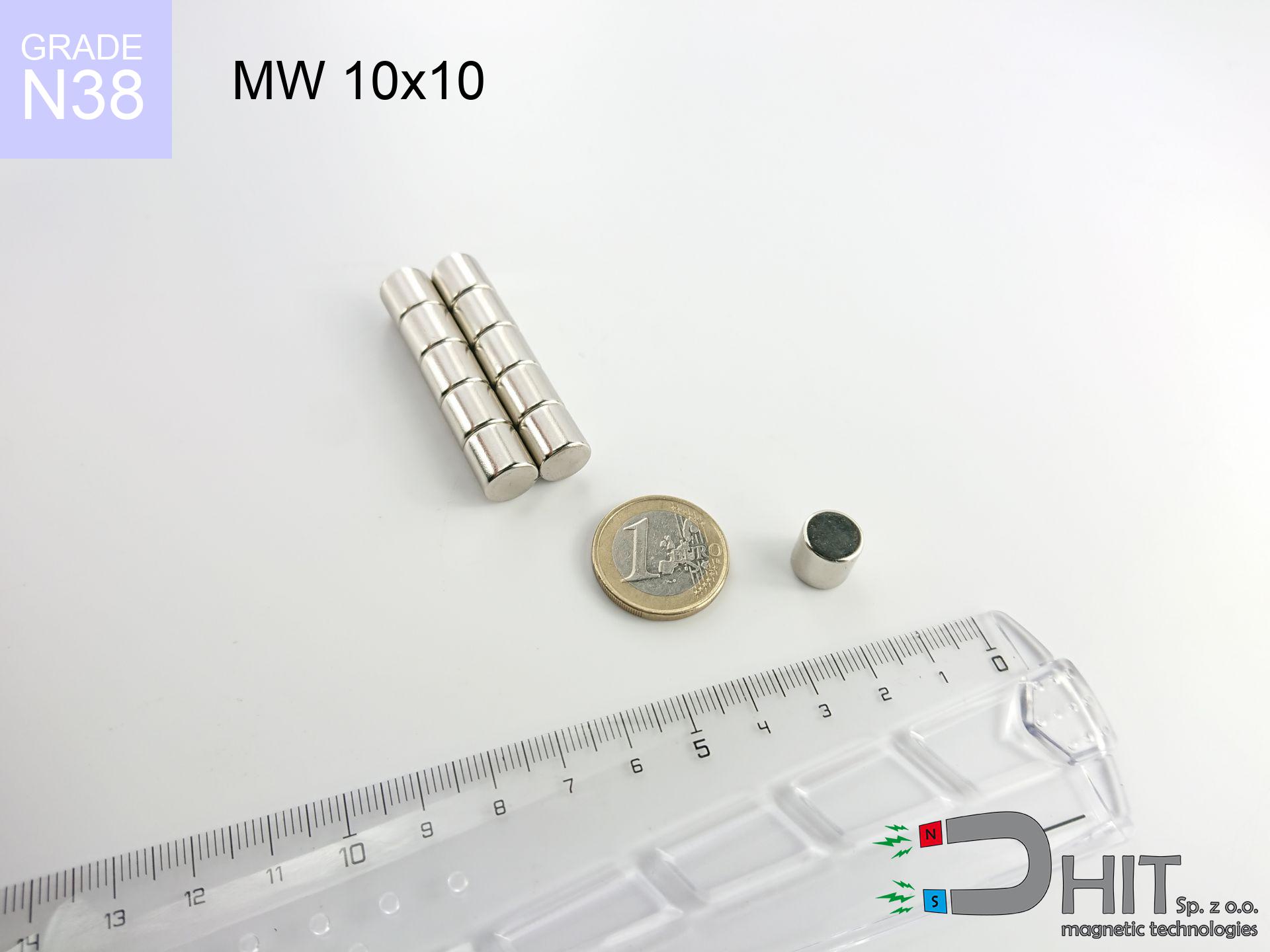MPL 20x10x1 / N38 - lamellar magnet
lamellar magnet
Catalog no 020126
GTIN: 5906301811329
length [±0,1 mm]
20 mm
Width [±0,1 mm]
10 mm
Height [±0,1 mm]
1 mm
Weight
1.5 g
Magnetization Direction
↑ axial
Load capacity
1.12 kg / 10.98 N
Magnetic Induction
87.15 mT
Coating
[NiCuNi] nickel
0.95 ZŁ with VAT / pcs + price for transport
0.77 ZŁ net + 23% VAT / pcs
bulk discounts:
Need more?Want to negotiate the price?
Call us +48 22 499 98 98 or write via form on the contact page. Test the magnet's power with our power calculator.
Orders placed by 14:00 are shipped the same day.
MPL 20x10x1 / N38 - lamellar magnet
Magnetic properties of material N38
Physical properties of NdFeB
Shopping tips
Thanks to their mighty power, flat magnets are regularly applied in devices that require exceptional adhesion.
Most common temperature resistance of these magnets is 80°C, but depending on the dimensions, this value grows.
Moreover, flat magnets usually have different coatings applied to their surfaces, e.g. nickel, gold, or chrome, to improve their durability.
The magnet with the designation MPL 20x10x1 / N38 and a magnetic strength ${capacity} kg weighing only ${weight} grams, making it the ideal choice for applications requiring a flat shape.
Contact surface: Thanks to their flat shape, flat magnets ensure a larger contact surface with adjacent parts, which is beneficial in applications requiring a stronger magnetic connection.
Technology applications: These are often applied in many devices, such as sensors, stepper motors, or speakers, where the thin and wide shape is necessary for their operation.
Mounting: Their flat shape makes it easier mounting, especially when it is required to attach the magnet to another surface.
Design flexibility: The flat shape of the magnets gives the possibility creators greater flexibility in arranging them in structures, which is more difficult with magnets of more complex shapes.
Stability: In some applications, the flat base of the flat magnet may provide better stability, reducing the risk of sliding or rotating. However, one should remember that the optimal shape of the magnet depends on the specific project and requirements. In some cases, other shapes, like cylindrical or spherical, may be more appropriate.
Magnets have two poles: north (N) and south (S), which attract each other when they are different. Similar poles, e.g. two north poles, act repelling on each other.
Due to these properties, magnets are regularly used in electrical devices, e.g. motors, speakers, sensors, or magnetic locks. Neodymium magnets stand out with the highest power of attraction, making them indispensable for applications requiring powerful magnetic fields. Moreover, the strength of a magnet depends on its size and the material it is made of.
It’s worth noting that extremely high temperatures, above the Curie point, cause a loss of magnetic properties in the magnet. The Curie temperature is specific to each type of magnet, meaning that under such conditions, the magnet stops being magnetic. Interestingly, strong magnets can interfere with the operation of devices, such as compasses, credit cards or medical equipment, like pacemakers. For this reason, it is important to avoid placing magnets near such devices.
Advantages and disadvantages of neodymium magnets
Neodymium magnets, also known as NdFeB magnets, are currently the strongest permanent magnets available on the market. Their exceptional magnetic properties make them suitable for various industries, technologies, and everyday life. Below are the key advantages:
- Immense attractive force: Even small neodymium magnets generate a very strong magnetic field.
- High coercivity: They are resistant to demagnetization by external magnetic fields.
- Wide operating temperature range: Standard neodymium magnets operate up to 80°C, with special versions up to 230°C.
- Variety of shapes and sizes: Available in many forms, making them easy to adapt to specific applications.
- Relatively low price compared to strength: They offer the best strength-to-price ratio among all magnets.
- Longevity: With proper use, they retain their magnetic properties for many years.
- Versatility of applications: From electric motors to speakers, separators, toys, and jewelry.
Despite numerous advantages, neodymium magnets also have certain disadvantages to consider:
- Brittleness: They are hard but brittle and prone to cracking or chipping upon impact.
- Limited operating temperature for standard versions: Above the Curie temperature, they lose their magnetic properties.
- Strong magnetic field can be dangerous: They can damage electronics, magnetic cards, and pose a risk of attracting metal objects with great force.
- Difficulties in mechanical processing: Due to their hardness and brittleness, processing them is complex.
Caution with Neodymium Magnets
Neodymium magnets are noted for their fragility, which can cause them to crumble.
Neodymium magnets are characterized by significant fragility. Neodymium magnets are made of metal and coated with a shiny nickel, but they are not as durable as steel. At the moment of collision between the magnets, small metal fragments can be dispersed in different directions.
Neodymium magnets should not be in the vicinity youngest children.
Neodymium magnets are not toys. You cannot allow them to become toys for children. In the case of small magnets, they can be swallowed and cause choking. In such cases, the only solution is to undergo surgery to remove the magnets, and otherwise, it can even lead to death.
Dust and powder from neodymium magnets are flammable.
Avoid drilling or mechanical processing of neodymium magnets. If the magnet is crushed into fine powder or dust, it becomes highly flammable.
The magnet is coated with nickel - be careful if you have an allergy.
Studies clearly indicate a small percentage of people who suffer from metal allergies such as nickel. An allergic reaction often manifests as skin redness and rash. If you have a nickel allergy, you can try wearing gloves or simply avoid direct contact with nickel-plated neodymium magnets.
Neodymium magnets can attract to each other, pinch the skin, and cause significant injuries.
Magnets may crack or alternatively crumble with careless joining to each other. Remember not to move them to each other or hold them firmly in hands at a distance less than 10 cm.
Neodymium magnets can become demagnetized at high temperatures.
Although magnets have demonstrated their effectiveness up to 80°C or 175°F, the temperature can vary depending on the type, shape, and intended use of the specific magnet.
Make sure not to bring neodymium magnets close to the TV, wallet, and computer HDD.
Strong magnetic fields emitted by neodymium magnets can destroy magnetic storage media such as floppy disks, credit cards, magnetic ID cards, cassette tapes, video tapes, or other devices. In addition, they can damage televisions, VCRs, computer monitors, and CRT displays. Avoid placing neodymium magnets in close proximity to electronic devices.
Neodymium magnets are over 10 times more powerful than ferrite magnets (the ones in speakers), and their power can surprise you.
Familiarize yourself with our information to properly handle these magnets and avoid significant injuries to your body and prevent disruption to the magnets.
Keep neodymium magnets away from GPS and smartphones.
Magnetic fields can interfere with compasses and magnetometers used in aviation and maritime navigation, as well as internal compasses of smartphones and GPS devices. There are neodymium magnets in every smartphone, for example, in the microphone and speakers.
People with pacemakers are advised to avoid neodymium magnets.
Neodymium magnets generate strong magnetic fields. As a result, they interfere with the operation of a pacemaker. This happens because such devices have a function to deactivate them in a magnetic field.
So you are aware of why neodymium magnets are so dangerous, see the article titled How dangerous are very powerful neodymium magnets?.









